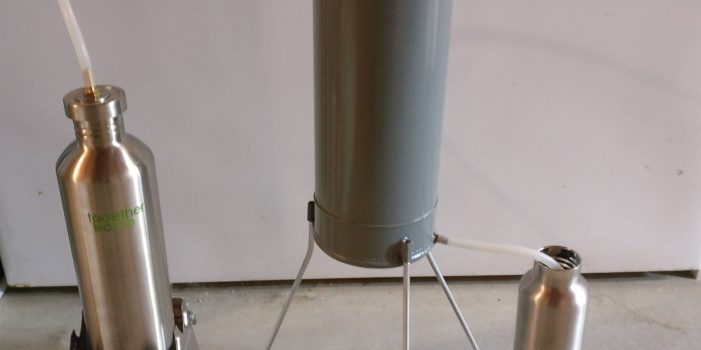Email a copy of 'A Portable Water Distiller- Part 2, by JMD' to a friend
6 Comments
- Ad Ready Made Resources, Trekker Water Filtration SystemUsed throughout the World
- Ad Civil Defense ManualHow to protect, you, your family, friends and neighborhood in coming times of civil unrest… and so much more, Go to www.civildefensemanual.com for contents.


I gotta say, this article is one of the better ones I have seen on Sblog in a long while.
However, for me, the most important part is the results. The three sentences you dedicated to discussing the results not only leaves me skeptical, but the lack of fire stains on your canteen seems suspect. I hope there is a part three, and better yet, a video to demonstrate your results could be just right. You have a heck of an idea here, which certainly could be very profitable for you. But, we need more evidence that this actually works. As intelligently mentioned in the comments section of yesterdays article, how much energy does it take to make this work? Does it work over a camp fire? Great concept and idea you have here, JMD. But, we need more evidence that it works.
All in all this is pretty cool. Wondering though about time needed to distill enough water to fill the 32 ounce container and I see the 55 ounce container is not currently available. I had not heard about nickel being poisonous and will read up on it. Makes me wonder about my cookware as the vast majority of it is stainless.
Okay, I read up on it. Briefly but it is real. Also copper and aluminum which are also used in cookware. It’s more of a concern with acidic foods and tends to be less problematic with after repeated use. Meaning less of it leaches out as the pot is used.
We drank many gallons of reverse osmosis water while sailing. We used a PUR Power Survivor 35 water maker. It made 1.2 gallons an hour and we ran it off of our solar panels. Katadyn now owns PUR and the newer model is a Power Survivor 40 which costs close to 4 grand. The Survivor 35 was a manual model that depended on working a lever to generate the pressure needed to push the water through the membrane. These are still supported by Katadyn and parts are readily available. Support should continue as these are part of the Navy’s life raft survival kits. You can buy them for about 2400 dollars. They are frequently available on eBay (maybe military surplus?) but if buying used plan on doing a rebuild and check with Katadyn for prices. The membrane will need to be replaced periodically but this can be prolonged by “pickeling” between uses. Again, check with Katadyn. there is an even smaller unit called an 06 which is about the size of a cigar box. $1200 dollars and it makes just shy of a quart an hour. these are also used by the military and are packed in pilots bailout survival kits.
I have no affiliation with Katadyn but I did like the PUR power survivor a lot!
Very good article but if I was going to do a distillation unit I think I’d go for a solar still type setup. It could be be fairly large and would be passive. Kind of the reverse of a solar dehydrator.
I did enjoy the article and think it was slightly Rube Goldbergish which IMHO is a true complement. Not overly complicated and I’m wondering if anyone has any thoughts on a wood gas generator?
Muddykid – the reason there are no fire stains on the bottle is that I took the pictures while I was building it, not after I tested it. In terms of time, it took about 40 minutes to process a full boiler of salt water (from starting the fire to a full output bottle), and I had to wait 10 minutes or so for everything to cool down so I could pack it back up. Keep in mind this isn’t meant as a replacement for other water purification methods – my primary use case was for processing salt water.
Regarding profitability, I have absolutely no plans or desire to produce these. People are more than welcome to build them for their own use.
J.M., thanks for this follow up. The time to process the full boiler sounds pretty reasonable. I think I am going to try and make one. Very cool idea and design.
Thank you for this very interesting article, and also for testing your design out in real life. I’ve seen a lot of creativity that’s never actually put to the everyday use test. Since you drank the water your kit produced, that’s good enough for me. I also appreciated the info about water testing kits at Home Depot. This method of producing drinkable water seems like a winner and right now is a good time for home experimentation and practice, well before the time it’s suddenly needed. Your hard work and clear instructions are appreciated!
Nice article. Down where I come from the copper coil is called a worm and you need a “thumper” to keep from wasting steam. The soil is poor where I live so the locals sold shine to make end meet during the depression.